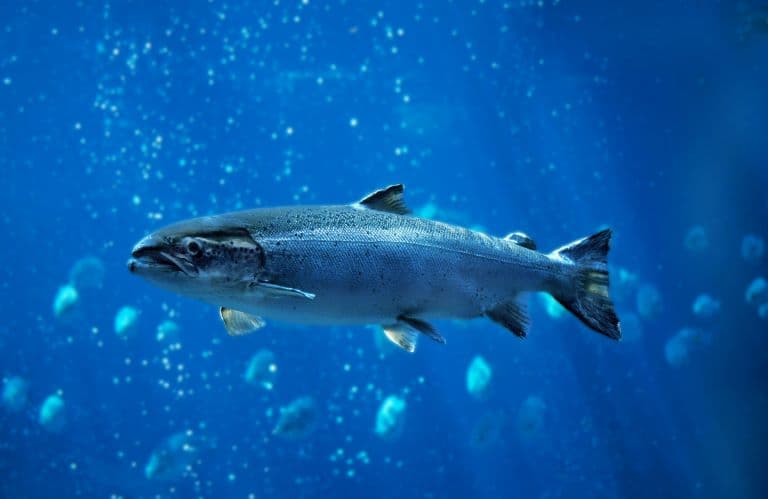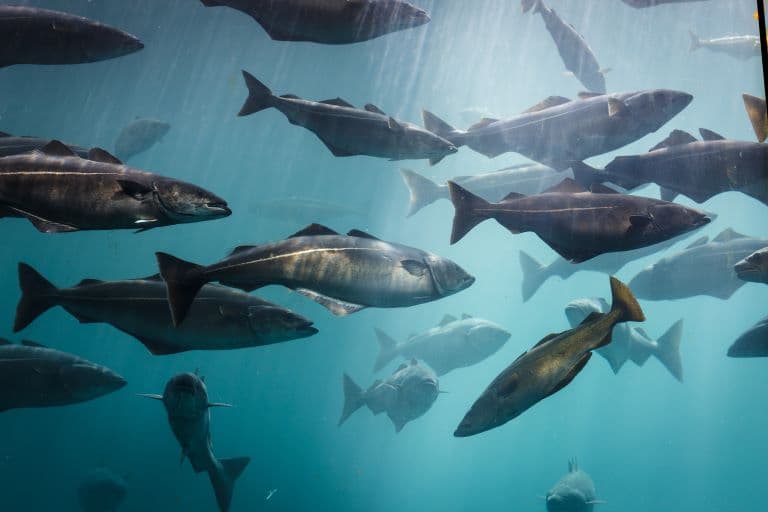Salmon Profile
Not many animals are tough enough to move between salt and freshwater at will. Some mammals can do it, a croc or two, and a handful of fish.
Salmon, from the Aussie shorthand genus “Salmo” are one of them. And while we typically associate them with dill or sashimi, there’s much more to these fish than we give them credit for.

Salmon Facts Overview
| Habitat: | Cold water, subarctic |
| Location: | North Atlantic, North Pacific |
| Lifespan: | 13 years in the Atlantic Salmon |
| Size: | 150 cm (4 ft 11 in) in larger species |
| Weight: | Up to 61.4 kg (135 lb) in the Chinook salmon |
| Colour: | Silvery-grey to bright red |
| Diet: | Fish, insects, crustaeans |
| Predators: | Bears, otters, ospreys, fish eagles, beavers, insects, fish, reptiles |
| Top Speed: | 5km/h (3 mph) cruising speed, top speed unknown |
| No. of Species: | 7+ |
| Conservation Status: | Least Concern or Data Deficient |
Salmon are a group of trout that are distinguishable from the others mostly in terms of culinary preference. But humans are far from the only animals who eat them; they’re extremely important as a food source for hundreds of species.
Unfortunately for a fish, this tasty, most of them don’t make it to adulthood, and those who do are often forced to take part in epic migrations through a gauntlet of predators to return to their spawning locations.
Interesting Salmon Facts
1. They’re in the trout family
Salmon are one of those legendary animals whose taxonomy is easy for zoologist students to remember because it’s just Salmon all the way down. Once you know they’re bony fish (Actinopterygii), the rest is just salmon with the appropriate suffix for the tier.
They’re in the order Salmoniformes, the family Salmonidae, the subfamily Salmoninae and at least one genus is just Salmo.
If only all animals were this easy, Dogidae and Catidae would get a lot more attention because revision would take no more time at all.
But to complicate things, as is necessary for taxonomic disciplines, trout, char, graylings and whitefish are also in the Salmoniformes family, and there doesn’t appear to be a single definition of what constitutes a salmon taxonomically, and the name seems to relate more to their commercial significance as types of food, which is a bit disrespectful to the fish, really.
2. They’re euryhaline
One of the coolest features of salmon is their ability to tolerate varying salinity in their aquatic habitat. This is something that doesn’t seem impressive at first glance but really is quite rare.
Most aquatic animals have a very narrow range of salinity that they can tolerate. There are serval reasons for this, but in short, it’s very expensive to either keep salt out or keep water in, or vice versa, and this usually involves specialised organs that have evolved for this purpose.
To switch between freshwater and saltwater and still breathe through gills, you have to have some very special hardware due to the extreme shift in osmotic pressure that you get from inverting the salinity of the water.
While skin is designed to hold water and salt on the correct side of it, lungs and gills are designed to be quite the opposite, and allow molecules to permeate in and out of the body as part of the respiration process. Unfortunately, this also allows moisture and salt to pass through, hence the need for special equipment to maintain equilibrium.
Species that can move between fresh and saltwater are rare and known as euryhaline species. When they enter freshwater, the salinity of their blood pulls water into their bodies through the gills, so they have special kidney adaptations to dump copious amounts of urine in response.
When they go back, all the salt in the ocean tries to pull the relatively fresher water out of their bodies, so the kidneys concentrate the urine as densely as possible to reduce the loss of water used to remove waste.
They also have special cellular pumps that push the increasing salt load out of their bodies and back into the water to offset the influx of salt in the ocean. When they enter freshwater, these pumps reverse, pulling the limited amounts of salt from the water back into the salmon’s body!
This isn’t a feature in all salmon species; some are restricted to freshwater their entire lives, particularly if they live in an enclosed lake. 1

3. This allows them to take on epic migrations
This ability to exist comfortably in freshwater and saltwater means the salmon can take advantage of the relative safety of freshwater gravel beds to spawn their eggs, then flee to the ocean, where bears can’t catch them.
Of course, if you go all the way to the ocean as an adult, you have to get back again to breed, and salmon are well known for these impressive migrations, often involving desperate struggles to splash the wrong way up some rapids while nature photographers watch in admiration and refuse to help.
It was always thought that a salmon would return to the very gravel bed from which it hatched, and this is true more often than not, though it’s not a strict rule. It seems that there’s a smell-based form of navigation that helps the fish navigate back, but this is an insurmountable journey for many.
Humans do help occasionally. When a landslide blocked off a known salmon run, people rushed to intervene. Over 26,000 salmon started that journey, and even with help, only 88 made it to their location.
Those that arrive are exhausted, having not eaten for the entire trip. Once they spawn, most species will die there, but others can spawn more than once. 2

4. They’re keystone species
Salmon were once much more abundant. In a single location, there can be well over 100 species that feed on them, making them critically important as a food source to many community members.
2% of those that hatch will make it to adulthood, as fish, birds, insects, mammals, reptiles, and everything in between will take advantage of them at one or more stages of their lives. Even fewer will make it back to spawn. 3
5. They are spirit guides
The ‘Noble Savage’ fallacy suggests the romanticized vision of prehistoric humanity as caretakers of their environment is largely a myth; humans were in most cases just as greedy and destructive as they are today, there were simply too few to cause as much harm, and their equilibrium was likely a product of the limitations of the species, rather than any intelligent concern for nature.
But some cultures show us humans aren’t always this way. Various North American indigenous peoples relied on salmon for food, but they also took spiritual guidance from the fish. And in some of them are indeed lightyears ahead of Western values when it comes to ecological balance.
The Yurok tribe had a taboo against taking the earliest arrivals of salmon on their spawning trip up the rivers. They knew the importance of maintaining healthy populations for future harvests, and would only take salmon once they were back in abundance.
Some tribes were known to make sure the full fish was used, so as not to waste any, and would take part in salmon ceremonies, welcoming the first fish back, celebrating the first cooking of the salmon, and then returning the bones to the sea as thanks.

6. They have an unexpected relationship with lampreys
Salmon and lampreys have an interesting arrangement. It was noticed that when lampreys drop in rivers, so do salmon.
As it happens, the lamprey is a great decoy species for the salmon, one that hugs the banks, swims badly and contains a lot more fat. This makes them a preferred catch for many of the would-be predators of salmon. 4
Salmon Fact-File Summary
Scientific Classification
| Kingdom: | Animalia |
| Phylum: | Chordata |
| Class: | Actinopterygii |
| Order: | Saloniformes |
| Family: | Salmonidae |
| Subfamily: | Salmoninae |
Fact Sources & References
- “Acclimation of Osmoregulatory Function in Salmon”, The University of New Mexico.
- KATE HELMORE (2022), “Insurmountable: The battle to bring a salmon run home”, Canadian Geographic.
- “Salmon Life Cycle”, 5C Program.
- Ann Constantino (2017), “PACIFIC LAMPREY’S BIG YEAR”, Kym Kamp.
